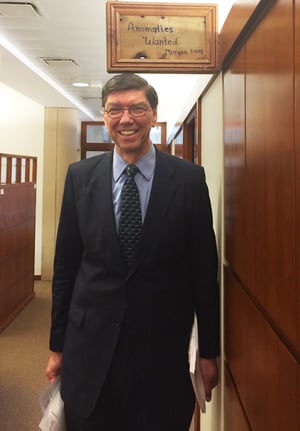
As a Product Manager for HBX, I have the good fortune to work with Clayton Christensen, an expert on strategy, innovation, and growth.
Professor Christensen’s MBA course Building and Sustaining a Successful Enterprise is the most popular elective at Harvard Business School and is based on his book The Innovator’s Solution, the sequel to the enormously impactful The Innovator’s Dilemma.
Having written more than nine books on disruption and innovation, Clay has also founded a nonprofit institute, a consulting firm, and a boutique investment firm – all focused on disseminating his research and ideas on innovation. With such a large global presence, one would think that Clay Christensen wouldn’t need any more help scaling his ideas.
However, last year, the team at HBX worked diligently with Clay to produce and launch the first ever HBX Course: Disruptive Strategy with Clayton Christensen. We recently caught up with Clay and asked why he chose to put his content online, even after seeing success with his other initiatives. The answer was two-fold and (not surprisingly) mirrors Clay’s very own theories.
Creating maximum exposure
According to Clay, online learning can scale in a way that no other type of learning can. Harvard Business School is a selective and expensive graduate program that only benefits 900 students per year; and even then there are enough seats in Clay’s course for only a third of them.
As Clay explained, “I put [my content] on the HBX platform because if I don’t do that, then every year at maximum 900 people will be exposed to the theories…and many more people need to have access.”
By using the HBX platform as a digital thoroughfare, the theories of disruption, innovation, and successful strategic growth no longer need to be exclusive and can now help organizations that are both large incumbents in need of change, but also small and agile that may not be able to afford a consulting session.
Reaching new audiences
By leveraging the reach of the internet, Clay’s theories can now be consumed by organizations in distant locales that don’t have access to conferences and speaking events. While Clay often travels, HBX Disruptive Strategy can travel to any place in the world that has electricity and an internet connection, thus opening up new markets for this high level educational content.
In fact, one of HBX’s most recent cohorts is a small nonprofit organization in Lagos, Nigeria called West Africa Vocational Education (or WAVE). WAVE’s mission is to tackle youth unemployment in West Africa, and they believe that Clay’s theories will help them execute on their mission in a much more effective and sustainable way, making a much larger impact on their community.
Clay agrees: “Managers will be much more successfully innovative if they take this course. If they don’t take the course, either they have to try to be successfully innovative by trial and error, or listen to opinions of where the market is going. But there is no data that can guide [them] as [they] look into the future. Having a theory to guide you gives a tremendous advantage.”
The power of collective learning
One might argue that with so many copies in print and the tremendous growth of online retailers like Amazon.com, Clay’s books would be able to reach many more people, and thus be the vehicle to scaling his theories. However, a book cannot capture the power of collective learning, particularly when the theories are needed by a team that is aiming to execute on difficult strategic change.
Clay is cognizant that when someone reads his book, they don’t always describe his theories in the best way. And then, like a game of telephone, the theories become distorted and lose their effectiveness as each person tells the next.
As Clay puts it, “I thought of myself as writing to millions of people, but I have realized that’s the wrong way to frame things. Because what I write is consumed individually by individual people who have a book or an article…everybody else on the team didn’t learn that way of thinking about the problem. Your readers are your resellers of the ideas; [and through] the process of selling and reselling, the idea just loses its momentum.”
Small group dynamics
Disruptive Strategy is designed with a strong, peer learning structure. Organizations are broken into teams who meet regularly to discuss what they have learned and how it applies to them and their unique strategic challenges. By creating this small group dynamic, participants of the course are not only motivated to engage with their fullest attention, but they all have the same experience and by the end of the course speak the same language.
“The ideas are consumed by a group – and that’s when you come up with a new idea. There’s a whole cadre of people who understand the same concepts, [have] the same language and together they can teach everyone else [with] much more fidelity…and a consistent lens.”
We too believe that by utilizing our online platform and the technologies that are available to us, Clay’s timeless theories will have their maximum impact. We look forward to helping companies far and wide refine their strategies and implement innovative thinking.

 Clay Christensen developed the theory of disruptive innovation in 1995 to describe a process where a new product takes root at the bottom of an existing market and works its way up, disrupting existing companies whose offerings may be too expensive or otherwise inaccessible to much of the market.
Clay Christensen developed the theory of disruptive innovation in 1995 to describe a process where a new product takes root at the bottom of an existing market and works its way up, disrupting existing companies whose offerings may be too expensive or otherwise inaccessible to much of the market.








